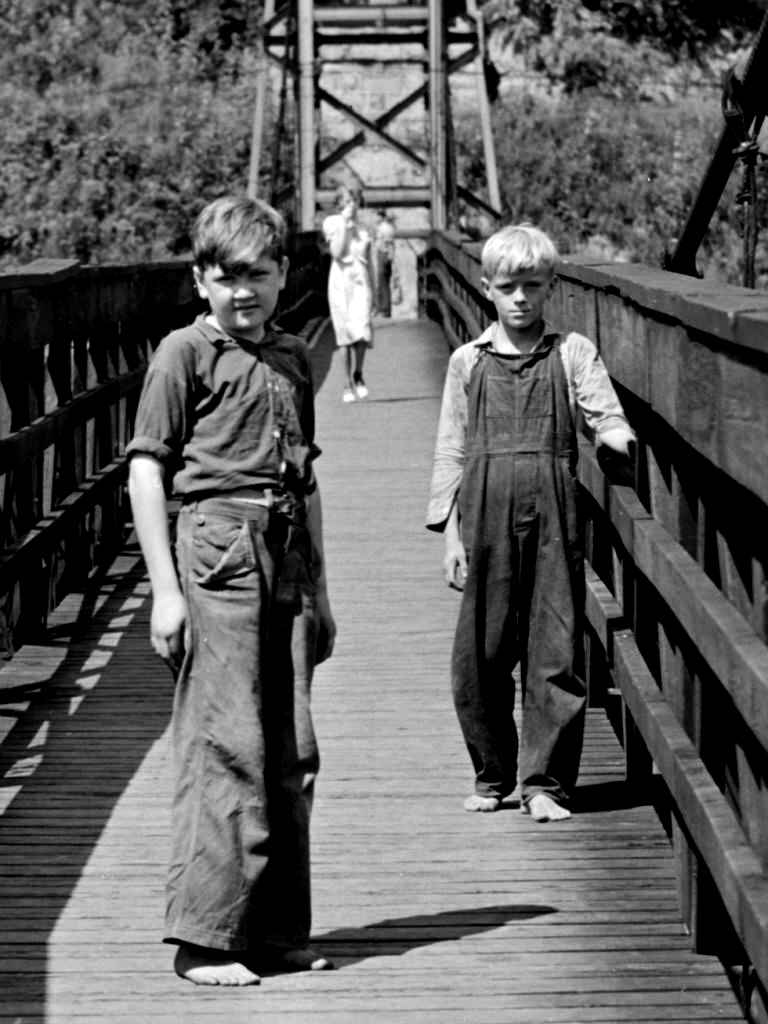
United States Boys' Clothes: The War Years (1940-45)

Figure 1.--These boys are the children of coal miners from Hazard, Kentucky. The photographwas taken in Jukly 1940 judtvas America was emerging from the Depression. They are crossing the swinging bridge from their homes into town. Knickers at the time were rapidly disappearing and boys were increasingly wearing long pants. We still see differences between rural and urban America. Overalls and barefeet wwre still common in rural America, but by the end of the War were no longer very common.
|
|
One important factor about the first half of the 1940s concerning clothing, including boys' clothing, is of course the War. America was at war from December 1941 to September 1945. While World War II introduced some military styles such as the Eisenhower jacket and help to popularize informal styles like jeans and "T"-shirts, rationing and unavailability played a bigger part than boys' (or their mothers') fashion sense. The Second World War resulted in a marked austerity in dress, due in large part to the restrictions placed on the clothing industry by the War Production Board. The war in Asia had a significant impact on womens's fashions. Shipments of silk were cut off. This gave a great impetus to the production of sythentic fibers like nylon which would eventually filter through to men and boys' fashions. Shortages of wool gave impetus to research into regenerated protein fibers. One result was the milk protein fiber Aralac. It made the advertising pages of Vogue, but consumers complained that when it got wet it smelled like sour milk! Fashion in America including children's clothes was constrained by the War. In 1942, "General Limitation Order L-85" placed restrictions on the quantity of fabrics used in apparel. With the exceptions of infants' and toddlers' clothing, bridal gowns, maternity dresses, burial gowns, and clothing for religious orders, regulations detailed a wide variety of specific restrictions on the cut of women's and girl's apparel. It limited the width of hems, abolished cuffs, and eliminated wide belts. Gone was the suit for men with two sets of trousers, and vests could not be sold with double-breasted suits. Extra pockets were abolished, as were pleats in trousers. The War did create one new fashion that would come to dominate boys' and eventualy girls' leisure wear. World War II also witnessed the birth of the "t" shirt. A part of military dress, this undergarment went on to a long civilian life after the war, and beginning in the late 1940s a "t" shirt with bright colored horizontal stripes became a main stay of American boyhood fashions. Most boys lived in "t" shirts, jeans, and Keds (sneakers). The L-85 regulations had the effect of "freezing" styles throughout the wartime period and beyond. Although the war ended in 1945, it took time for scarce textile products to come back to the market. One major development during the decade is that women and eventually girls began wearing pants which before the war had ben the almost exclusive preserve of men and boys. Glamorous film stars like Marlene Dietrich, Greta Garbo and Katherine Hepburn may be popularizing trousers for women, but the real rise of the pants is due to the shortage of stockings during World War II. Stockingless women hide their bare legs with trousers, which are also better for working the assembly-line jobs abandoned by male soldiers.
HBC

Navigate the Historic Boys' Clothing Web Site:
[Return to the Main U.S. 1940s page]
[Return to the Main 1940s page]
[Return to the Main U.S. page]
[Return to the Main U.S. post-war page]
[U.S. 1900s page>]
[U.S. 1910s page]
[U.S. 1920s page]
[U.S. 1930s page]
[U.S. 1940s page]
[U.S. 1950s page]
[U.S. 1960s page]
[U.S. 1970s page]
[U.S. 1980s page]
[U.S. 1990s page]
Navigate the Boys' Historical Clothing Web Site:
[Introduction]
[Activities]
[Biographies]
[Chronology]
[Clothing styles]
[Countries]
[Topics]
[Bibliographies]
[Contributions]
[FAQs]
[Glossaries]
[Images]
[Links]
[Registration]
[Tools]
[Boys' Clothing Home]
Created: 9:47 PM 4/2/2011
Last updated: 9:47 PM 4/2/2011



